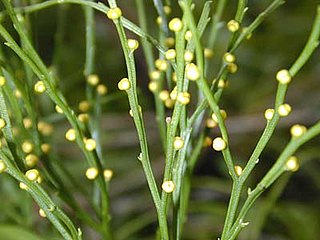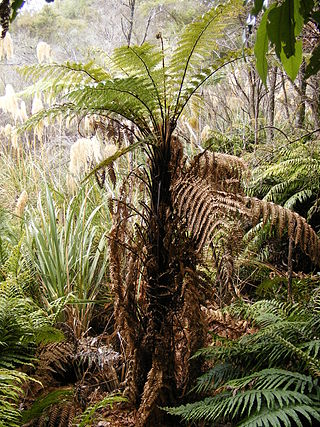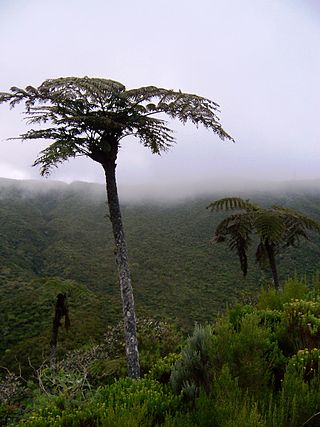
Tree ferns are arborescent (tree-like) ferns that grow with a trunk elevating the fronds above ground level, making them trees. Many extant tree ferns are members of the order Cyatheales, to which belong the families Cyatheaceae, Dicksoniaceae, Metaxyaceae, and Cibotiaceae. It is estimated that Cyatheales originated in the early Jurassic, and is the third group of ferns known to have given rise to tree-like forms. The others are the extinct Tempskya of uncertain position, and Osmundales where the extinct Guaireaceae and some members of Osmundaceae also grew into trees. In addition there were the Psaroniaceae including Tietea in the Marattiales, which is the sister group to most living ferns including Cyatheales.

The ferns are a group of vascular plants that reproduce via spores and have neither seeds nor flowers. They differ from mosses by being vascular, i.e., having specialized tissues that conduct water and nutrients, and in having life cycles in which the branched sporophyte is the dominant phase.

The order Cyatheales, which includes most tree ferns, is a taxonomic order of the fern class, Polypodiopsida. No clear morphological features characterize all of the Cyatheales, but DNA sequence data indicate the order is monophyletic. Some species in the Cyatheales have tree-like growth forms from a vertical rhizome, others have shorter or horizontal expanding rhizomes.

Dicksonia antarctica, the soft tree fern, Tasmanian Tree Fern or man fern, is a species of evergreen tree fern native to eastern Australia, ranging from south-east Queensland, coastal New South Wales and Victoria to Tasmania.

Sphaeropteris cooperi, synonym Cyathea cooperi, also known as lacy tree fern, scaly tree fern, or Cooper's tree fern, is a tree fern native to Australia, in New South Wales and Queensland.

Cyathea is a genus of tree ferns, the type genus of the fern order Cyatheales.

Dicksonia squarrosa, the New Zealand tree fern, whekī or rough tree fern, is a common tree fern endemic to New Zealand. It has a slender black trunk that is usually surrounded by many dead brown fronds.

The Cyatheaceae are a family of ferns, the scaly tree ferns, one of eight families in the order Cyatheales in the Pteridophyte Phylogeny Group classification of 2016. Alternatively, the family may defined much more broadly as the only family in the Cyatheales, with the PPG I family treated as the subfamily Cyatheoideae. The narrower circumscription is used in this article.

Sphaeropteris medullaris, synonym Cyathea medullaris, commonly known as mamaku or black tree fern, is a large tree fern up to 20 m tall. It is distributed across the south-west Pacific from Fiji to Pitcairn Island. Its other Māori names include katātā, kōrau, or pītau.

Sphaeropteris is a genus of tree ferns in the family Cyatheaceae. It has been treated as a subgenus within the genus Cyathea, but is accepted in the Pteridophyte Phylogeny Group classification of 2016.

Alsophila australis, synonym Cyathea australis, also known as the rough tree fern, is a species of tree fern native to southeastern Queensland, New South Wales and southern Victoria in Australia, as well as Tasmania and Norfolk Island.
Gymnosphaera biformis, synonyms Alsophila biformis and Cyathea biformis, is a species of tree fern native to New Guinea and the Maluku Islands, where it grows against trees in mossy forest and rain forest at elevations of 850–2200 m. The climbing trunk is very thin, only 1–2 cm in diameter, but can reach 3 m in height. The apex of the trunk is covered in scales. Two types of fronds are produced, simple pinnate fronds, which are sterile, and bipinnate fronds, which may be fertile. The stipe is smooth, glossy and very dark, almost to the point of being black. It is covered at the base with long, very dark scales that have a pale margin. Fertile pinnules are distinctly stalked and lobed. Sori occur in four pairs per pinnule lobe and lack indusia.
Alsophila camerooniana, synonym Cyathea camerooniana, is a species of tree fern native to Sierra Leone, Cameroon, northern Angola and western Uganda, where it grows in montane forest at an altitude of 900–1200 m. The trunk is erect and 2–3 m tall. Fronds are pinnate and 2–3 m long. The rachis ranges in colour from dark to pale and has some hairs on the underside. The stipe is dark and is covered with scales throughout. Where scales have fallen, small warts are present. The scales are glossy brown and have a thin, dull edge. Sori occur at the forks of veins and are covered by thin indusia, which range in shape from cup- to saucer-like.

Gymnosphaera capensis, synonyms Alsophila capensis and Cyathea capensis, is a regionally widespread and highly variable species of tree fern. It is indigenous to Southern Africa and South America.

Cyathea delgadii is a widespread species of tree fern. It is native to Central America, and much of South America. The specific epithet delgadii refers to Gancho do Generale Delgado, along the road to Caldas Novas, Brazil, where the type material was collected.
Alsophila humilis, synonym Cyathea humilis, is a species of tree fern native to Kenya, as well as the Usambara and Uluguru Mountains in Tanzania, where it grows in wet forest at an altitude of 1100–2000 m. The trunk of this plant is erect and 2–3 m tall. Fronds are pinnate and 1–2 m in length. Dead fronds are often retained in the typical variety, forming an irregular skirt around the trunk. The rachis and stipe are light brown in colouration. Scales are present towards the base of the stipe. They are dark, glossy, and have narrow, fragile edges. Sori occur at the forks of veins and are protected by thin, reduced indusia.

Alsophila is a genus of tree ferns in the family Cyatheaceae. It has also been considered to be a section in the subgenus Cyathea of the genus Cyathea.

Alsophila glaucifolia, synonym Cyathea glauca, is a species of tree fern endemic to Réunion. Little is known about this species.

Alsophila smithii, synonym Cyathea smithii, commonly known as the soft tree fern or kātote, is a species of tree fern from New Zealand.

Lophosoria quadripinnata(J.F.Gmel.) C.Chr. is a species of fern that, according to DNA molecular analysis, belongs to the family Dicksoniaceae, where it is placed in the genus Lophosoria. It is found in the Americas spanning from Cuba and Mexico to Chile. In Chile it is present in the area between Talca and Aysén including Juan Fernández Islands. In Argentina it grows only in the humid valleys of western Neuquén and Río Negro Province. Diamondleaf fern is a common name. In Spanish it is known as 'ampe' or palmilla, but one has to remember that there are several species of ferns called "palmillas" that have larger or smaller fronds, and which grow in colder climates. It is a medium-sized plant, growing to about 4–5 feet and even though the rhizome does not grow a trunk, it is clearly related to the other tree ferns due to features that were apparently already present in their common ancestor, like 'pneumathodes', and the rhizome which changed from the dorsiventral symmetry typical of the other ferns, to a radial symmetry typical of tree ferns. Their large and multiple pinnate fronds, with the petiole raised adaxially, and the hairs on the rhizome and lower part of the petioles, also resemble those of tree ferns. To identify the species, use the position and characteristics of the spores found on the fertile fronds. The genus already existed in the Cretaceous Period in southern Gondwana according to fossil remains found in Antarctica. The species is well known as an ornamental plant.













